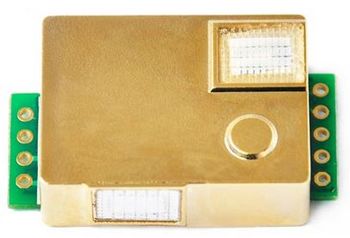Difference between revisions of "MHZ19"
| Line 1: | Line 1: | ||
{{Project | {{Project | ||
|Name=MHZ19 | |Name=MHZ19 | ||
| − | |Picture= | + | |Picture=mhz19.jpg |
|Omschrijving=Some research into the MH-Z19 CO2 sensor | |Omschrijving=Some research into the MH-Z19 CO2 sensor | ||
|Status=Initializing | |Status=Initializing | ||
| Line 7: | Line 7: | ||
}} | }} | ||
| + | == Introduction == | ||
| + | This page is about the MH-Z19 CO2 sensor and some experiments done with it. | ||
| − | This | + | This sensor gives a digital (serial) output of the CO2 concentration in air, in parts-per-million (ppm). |
| + | It uses the optical measurement principle of measuring CO2, which should be much more accurate than the inexpensive electro-chemical sensors you can find. | ||
| + | As far as I know, the optical measurement principle uses a broadband light-source to send some light through an air-sample. | ||
| + | The sensor then looks at the relative intensity of the light at two different frequencies. | ||
| + | The CO2 gas inside the air absorbs light strongly at very specific wavelengths, allowing a determination of the concentration (ppm) of CO2. | ||
| + | This is then compensated for temperature and pressure for increased accuracy. | ||
| + | A new measurement is started every 5 seconds, you can actually see a small amount of light coming out of the sensor while it's measuring. | ||
| + | |||
| + | The MH-Z19 is the cheapest optical CO2 sensor I could find on AliExpress. | ||
Revision as of 12:02, 22 October 2016
| Project MHZ19 | |
|---|---|

| |
| Some research into the MH-Z19 CO2 sensor | |
| Status | Initializing |
| Contact | bertrik |
| Last Update | 2016-10-22 |
Introduction
This page is about the MH-Z19 CO2 sensor and some experiments done with it.
This sensor gives a digital (serial) output of the CO2 concentration in air, in parts-per-million (ppm). It uses the optical measurement principle of measuring CO2, which should be much more accurate than the inexpensive electro-chemical sensors you can find. As far as I know, the optical measurement principle uses a broadband light-source to send some light through an air-sample. The sensor then looks at the relative intensity of the light at two different frequencies. The CO2 gas inside the air absorbs light strongly at very specific wavelengths, allowing a determination of the concentration (ppm) of CO2. This is then compensated for temperature and pressure for increased accuracy. A new measurement is started every 5 seconds, you can actually see a small amount of light coming out of the sensor while it's measuring.
The MH-Z19 is the cheapest optical CO2 sensor I could find on AliExpress.